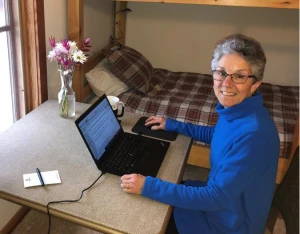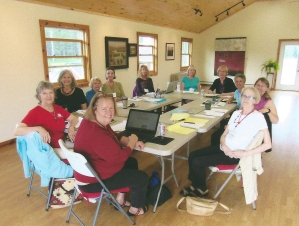It’s been a dry year for writing. After steadily plugging away on my book for over four years, I came to an abrupt halt. At first, I put it down to my usual summer slow-down, the season when I prioritize family, cabin, friends and the outdoors over sitting in front of a laptop. But I failed to get re-energized all through the fall and winter and felt lost, drifting without that goal and sense of productivity. I had to do something.
It was a writing friend who pointed me down a new path. I’ve always had an interest in sketching and was intrigued when I saw a distant cousin doing “journal sketching” years ago. The idea stuck with me, so when Gail recommended Jane LaFazio‘s online class Sketching and Watercolor: Journal Style I took the plunge.
The class included six lessons, one released every week for the students to work on independently. I ordered her list of supplies and waited eagerly to begin.
Week 1: Fruit. I watched her video, read all the instructions, and looked at her examples. Could I really do this? I pulled a sheet of thick watercolor paper off the 5×7″ pad she recommended and lined up my drawing pencil and kneadable eraser. Setting pencil to paper, I took a deep breath and began to follow the outline of the fruit in front of me. This was a rough draft, after all, and I could always hit delete and rewrite it.
Pulling out my permanent ink pen, I traced my pencil lines. There was no going back here, each stroke of the pen was a final statement – a sentence I could no longer change. But it went surprisingly well and I forged on.
The final step was all new territory to me. I opened up my children’s set of watercolors that Jane assured us were a good inexpensive starting point. Now I had to mix colors, blend shades and capture the nuances of light and color. I still have a lot to learn about writing scenes, and this felt the same way. I needed to make this come to life, now with water and paint. With Jane’s reassuring voice in my head, I applied my brush strokes as best I could.
For the journaling aspect, Jane encouraged us to frame our paintings, to add words and context to the composition, and to sign and date it. She was right, it added the polish my timid start needed, the final edit to complete the story.
Voila, I had my first painting!
Now it was time to share my work. The final step was to post my painting on our class discussion page with a note about the experience. Just like reading my stories aloud in writing workshops and hearing others read, this became a valuable learning experience. We all opened ourselves to exposure, gave feedback and encouraged one another on this journey. In addition, Jane commented on each and every painting, always providing encouragement infused with helpful tips and insights.
Buoyed by my first attempt, I bought more fruit and continued painting and posting throughout the week.
Week 2: Leaves. Who knew there were so many colors of green in the plants around us? Jane taught us to mix colors, to layer them on the paper and reveal the veins in the leaves. I revelled in the new techniques, but lacked material in our bleak Northland spring that had not yet sprung. Just as story and plot have evaded me as a writer, I had to get creative and find alternate ways to express myself. This time, foraging in the refrigerator and tub of spring greens I found inspiration.
I liked these small compositions. I was not overwhelmed by a large expanse of white paper, and a complex layout. They were a manageable size, something that could be accomplished in one or two sittings. Just as the magazine stories I have continued to write this year while my book lays fallow. Short projects that were contained and manageable.
Week 3: Straight to Ink. Now this was a scary concept, drawing with no safety net. Committing immediately with no recourse. Sort of like those writing prompts I’ve done in classes. Write about the color Red for five minutes. Don’t look back, just keep writing.
We warmed up with continuous line drawings. Keep your pen on the paper without lifting it, go over existing lines if you need to. I was skeptical, but it turned out to be fun. Then we drew with our non-dominant hand. The results were wobbly and sometimes a bit wonky, but I had to admit there was a bit of charm. It made me realize that left alone, my drawing is very controlled and precise. It takes work to let myself go and let the lines just flow.
We were granted permission to raise our pens in our subsequent drawings, but it was still hard to commit to ink right out of the gate. I found that it forced me to keep my eyes on the subject more, and trust my hand to follow its outline. The longer I kept at it, the bolder I became. I learned to embrace the irregularities and appreciate the end result. Perhaps I need to do more of that in my writing. Ignore the wiggles and blips and just let the words come. Sort it out with color later.
Week 4: Flowers. I was learning to like sketching and painting nature. It’s very forgiving in its irregularities and loose symmetry. This time it took purchasing a bouquet at the grocery store for my subjects, while I gazed wistfully at the garden flowers from fellow students in warmer climes.
My bouquet contained some brilliantly colored blooms, impossible to replicate with my student paints. I queried Jane. “How do I make hot pink?” Her reply, “You can’t. You need specific colors like Opera Pink to get it.” Clearly my toolkit was lacking, so I researched the more professional paints she had recommended for those willing to pay the price. I was now one of those. I hit Place Order.
Perhaps this was like hiring a writing coach. When I found myself unable to navigate the divide between writing short magazine stories and the manuscript for a book, I sought to increase my toolkit. She guided me through exercises to grow my skills, to learn new techniques and put me on a course to continue working on my own.
While I waited for my new paints to arrive, I did the best I could with the materials at hand, and finished up with some pastel flowers.
Week 5: Shoes. I just knew I was going to like this lesson. Shoes provided such a vast array of choices. This one in particular provided numerous comments and camaraderie when we posted our paintings. I found great fun and inspiration in the shoes my fellow students chose, and how they rendered them with ink and watercolor. Students ranged from novices like me to those with obvious artistic talent, and I learned from every one of them. I also admit to borrowing some of their ideas and techniques.
Clearly this was why my writing coach instructed me to read every book in my genre that I could get my hands on. I learned what worked and what didn’t. What made me want to keep reading, and what caused me to quit reading some books.
I dove into my own closet first, then succumbed to the cuteness factor of my grandchildren’s footwear. Sometimes it’s the subject matter itself that makes a creation shine, whether it’s in print or paint.
Week 6: Man Made Objects. This lesson incorporated techniques for drawing to scale, maintaining symmetry and the artistic license in choosing what details to leave in or exclude. Not wanting to copy Jane’s example of a wine bottle with a classy label, I stumbled on a bottle of Amaretto in the pantry. It contained plenty of challenges for getting the proportions right, and I worked through her methods to complete my drawing. But the thought of replicating the bumpy texture of the bottle and the shiny glass was daunting, so I set it aside. When I completed painting a kettle and tea cup, that first drawing taunted me, daring me to complete it. I accepted the challenge.
Sometimes stories don’t go well. Chapters just won’t work. I’ve found that if I leave them alone for a while, rather than using blunt force to push through them, the answer becomes more clear. Or my confidence surges. And the end result is greatly enhanced. So it was for my Amaretto. Along with the help of my new paints!
I have completed my class, but not my painting. I have a lot of practicing to do, especially mastering those finicky watercolors. I found that I look forward to these art projects, and they can absorb a whole morning or afternoon just as writing did in the past. I did have a niggling worry that I might supplant my writing time with sketching and painting. That I might transfer my allegiance from creating with words to ink and color.
I went into this new venture hoping to stimulate my creativity, to open that side of my brain hoping it would spur on my writing as well. If I had my way, I would marry the two. Use my ink and color to illustrate my words. But I’m not there yet.
The biggest hurdle with my book is that I cannot see the true thread, feel the message I am meant to be sending, the audience I seek to serve. Learning to draw and paint hasn’t solved that for me, but clearly it has taught me many transferrable lessons. So for now, I will continue my new art and wait for the words to come.


















































